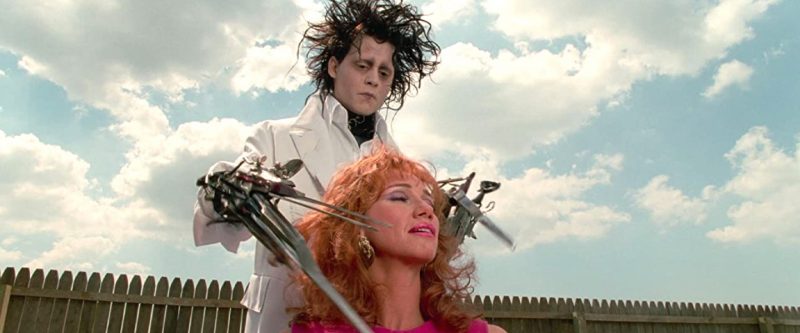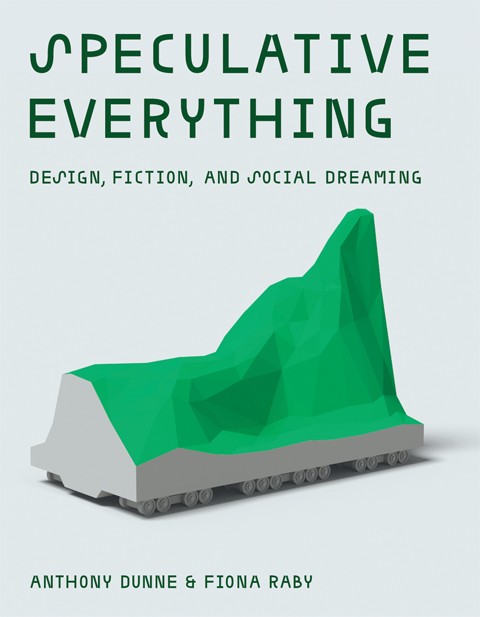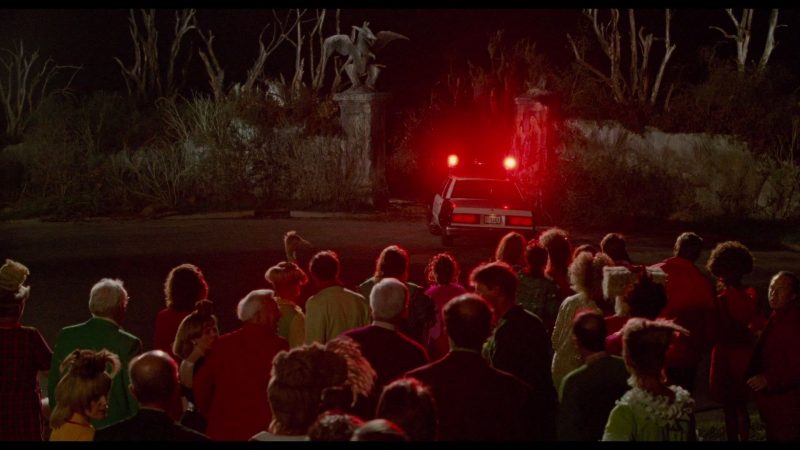Edward Scissorhands as Speculative Design
Posted on November 24, 2021The other week, I watched Edward Scissorhands for the first time. While I didn’t know it at the time, this film would provide a relevant example of speculative design, a form of design-based activism that my class would cover days later.
Here’s a basic rundown of the plot:
The movie is set in a white suburban neighborhood in the 1950s. Overlooking the town is an old mansion on top of a hill where years ago an inventor created Edward, a man with scissors for hands.
Edward has lived alone in the mansion his entire life and presumably, hasn’t interacted with anyone until Peg, a woman from the town below wanders in. She meets Edward, sees the scars on his face and his scissor hands, and out of sympathy, brings him home to live with her family.
The remainder of the film documents Edward’s journey as he yearns to be accepted by the neighborhood but struggles to integrate into the community and remains an outsider. Men laugh at his expense, children find him scary and teenagers cajole him into breaking the law, nearly getting him killed. At the same time, others in the neighborhood take advantage of Edward’s generosity and sculpting talent by asking him to cut the hedges on their lawns, the hair on their heads and the fur on their dogs into artistic masterpieces. Several women in the neighborhood also become infatuated with Edward and reinforce his otherness by fetishizing his exoticness, flirting and asking him to touch them with his scissor hands.

Edward gives a haircut to Joyce, one of the neighborhood residents.

Fast forward five days. In class, we learned about speculative design – a form of design-based activism that plays the long game. In their book, Speculative Everything: Design, Fiction and Social Dreaming Anthony, Dunne and Fiona Raby (2013) contrast this practice with traditional design disciplines: Unlike traditional design approaches that focus on the here and now, speculative design reimagines and represents alternative futures with the goals of provoking and generating new ways of thinking. This form of design is based on the premise that in order to prompt real change, we first must change our beliefs, attitudes and values, which can only happen through exploring alternatives. As Dunne and Raby write, “This form of design thrives on imagination and aims to open up new perspectives on what are sometimes called wicked problems, to create spaces for discussion and debate about alternative ways of being, and to inspire and encourage people’s imaginations to flow freely. Design speculations can act as a catalyst for collectively redefining our relationship to reality” (Dunne and Raby, 2).
Edward Scissorhands can be classified as a work of speculative design because of its stylistic and semantic resemblance. First, Edward Scissorhands employs a key visual tool of speculative design. The visceral effect of a well-executed speculative design project results from portraying futuristic scenarios with high visual fidelity. Representing alternative futures realistically increases perceived feasibility of such scenarios occurring, forcing viewers to contend with what might happen if such realities actually came into fruition. The creators of the Edward Scissorhands employ this speculative design tool by making Edward’s hands look realistic, albeit less so by today’s cinematic standards than when the film was released in 1990. Having scissors for hands may sound like a stretch, but given the advanced state of prosthetic technology, it’s not unthinkable that one day someone could live with everyday objects for hands. Edward Scissorhands can also be considered a piece of speculative design because it accomplishes exactly what speculative design seeks to do: It elicits a strong emotional reaction from the viewer and forces them to reconsider current practices.
As a piece of speculative design, Edward Scissorhands offers provocative commentary on the ways that mainstream society treats those who live on the margins. Edward’s character, whose identity is defined by what makes him different, represents individuals with marginalized identities. The neighborhood’s exploitation of Edward mirrors a trend in our current reality in the U.S.
Just as the neighborhood women benefit from Edward’s yard work and hairdressing but do not compensate him, mainstream white culture in America benefits from elements of Black culture but continues to disenfranchise and harm Black individuals. Examples of this appropriation abound in music with the popularity of color-blind rap and hip-hop among white audiences (Rodriquez, 2006) and in fashion with white celebrities who create and sell fashion items either designed by Black people or inspired by Black culture but do not give credit or compensation to the source of these fashion designs (Lawrence, 2017). In the latter case, despite benefitting from practices originating in Black spaces, influential non-Black celebrities such as the Kardashian-Jenners reinforce racial inequities by deriving profit from “…cultural items that were both inspired African American fashion from the 1990s and created by Black designers,” while leaving behind lesser known Black entrepreneurs selling the same cultural capital (Cherid, 2021, 360).

Photo Illustration by Lyne Lucien/The Daily Beast
Isolated acts of exploitation may appear minor, but the Edward Scissorhands metaphor portends a dark future for marginalized individuals if those in power continue to exploit.
From a speculative design perspective, the message of Edward Scissorhands is that small acts of exploitation can quickly accumulate into severe harm. The town first exploits Edward with requests for lawn maintenance, haircuts and dog grooming, but by the end of the movie, Edward’s work is visible at every turn. However, despite having contributed immensely to the homes, hairstyles and hounds of the neighborhood, when Edward accidentally scratches his adopted brother, the neighborhood turns on him. What began as adoration and fetishization ends in hate and aggression. In one of the final scenes, the residents literally chase Edward out of town, forcing him to hide the rest of his life in the mansion, far away from them.

Neighborhood residents follow a police car to the edge of town to ensure that Edward has left.
Thus, the town’s exploitation of Edward causes more than social isolation – it creates an expectation that he will continue to provide, allowing no room for mistakes or deviation from his prescribed role.
Like Edward, if nothing disrupts today’s patterns of exploitation and dependence on the contributions of marginalized groups, they can become vulnerable not only to disenfranchisement but to violence from members of the dominant circles of society.
The Edward Scissorhands metaphor-turned-speculative-design asserts that if we continue to allow individuals’ marginalized identities to be exploited, the resulting norms can open the door to severe harm.
MH
References
Burton, T. (1990). Edward Scissorhands. Twentieth Century Fox.
Cherid, M. I. (2021). “Ain’t Got Enough Money to Pay Me Respect”: Blackfishing, Cultural Appropriation, and the Commodification of Blackness. Cultural Studies↔ Critical Methodologies, 21(5), 359-364.
Dunne, A., & Raby, F. (2013). Speculative everything: design, fiction, and social dreaming. MIT press.
Lawrence, S. (2017, July 6). Kylie Jenner and Khloe Kardashian accused of stealing ideas from indie black designers. Teen Vogue. https://www.teenvogue.com/story/kylie-jenner-khloekardashian-stealing-black-designers
Rodriquez, J. (2006). Color-blind ideology and the cultural appropriation of hip-hop. Journal of Contemporary Ethnography, 35(6), 645-668.